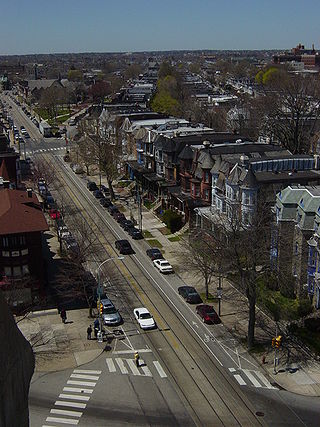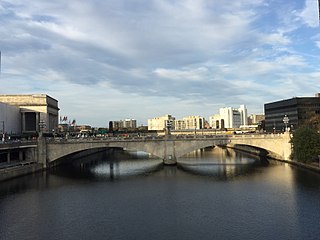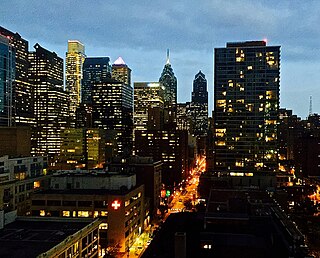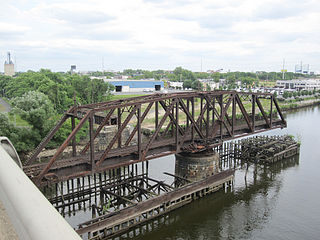
West Philadelphia, nicknamed West Philly, is a section of the city of Philadelphia. Although there are no officially defined boundaries, it is generally considered to reach from the western shore of the Schuylkill River, to City Avenue to the northwest, Cobbs Creek to the southwest, and the SEPTA Media/Wawa Line to the south. An alternate definition includes all city land west of the Schuylkill; this would also include Southwest Philadelphia and its neighborhoods. The eastern side of West Philadelphia is also known as University City.

The Schuylkill Expressway, locally known as "the Schuylkill", is a freeway through southern Montgomery County and the city of Philadelphia. It is the easternmost segment of Interstate 76 (I-76) in the U.S. state of Pennsylvania. It extends from the Valley Forge interchange of the Pennsylvania Turnpike in King of Prussia, paralleling its namesake Schuylkill River for most of the route, southeast to the Walt Whitman Bridge over the Delaware River in South Philadelphia. It serves as the primary corridor into Philadelphia from points west. Maintenance and planning for most of the highway are administered through Pennsylvania Department of Transportation (PennDOT) District 6, with the Delaware River Port Authority (DRPA) maintaining the approach to the Walt Whitman Bridge.

Philadelphia's Baltimore & Ohio Railroad station – also known as the B & O station or Chestnut Street station – was the main passenger station for the Baltimore & Ohio Railroad in Philadelphia, Pennsylvania. Designed by architect Frank Furness in 1886, it stood at 24th Street and the Chestnut Street Bridge from 1888 to 1963.

Pennsylvania Route 23 is an 81.14-mile-long (130.58 km) state highway in southeastern Pennsylvania. The route begins at PA 441 in Marietta and heads east to U.S. Route 1 at City Avenue on the border of Lower Merion Township and Philadelphia. PA 23 begins at Marietta in Lancaster County and continues east to Lancaster, where it passes through the city on a one-way pair of streets and intersects US 222 and US 30.

The Phoenix Iron Works, located in Phoenixville, Pennsylvania, was a manufacturer of iron and related products during the 19th century and early 20th century. Phoenix Iron Company was a major producer of cannon for the Union Army during the American Civil War. The company also produced the Phoenix column, an advance in construction material. Company facilities are a core component of the Phoenixville Historic District, a National Register of Historic Places site that was in 2006 recognized as a historic landmark by ASM International.

The West Philadelphia Elevated, also known as the High Line or Philadelphia High Line, is a railroad viaduct in the western part of Philadelphia, Pennsylvania. Now part of the Harrisburg Subdivision of CSX Transportation, the viaduct was built in 1903 by the Pennsylvania Railroad (PRR) to allow through freight trains to bypass rail yard, industrial sidings, and a passenger station.

The Market Street Bridge carries Market Street, the primary east-west street in Philadelphia, Pennsylvania, across the Schuylkill River. The current bridge is the fifth permanent structure built at the site.

Chestnut Street is a major historic street in Philadelphia, Pennsylvania. It was originally named Wynne Street because Thomas Wynne's home was there. William Penn renamed it Chestnut Street in 1684. It runs east–west from the Delaware River waterfront in downtown Philadelphia through Center City and West Philadelphia. The road crosses the Schuylkill River on the Chestnut Street Bridge. It serves as eastbound Pennsylvania Route 3 between 63rd and 33rd Streets.
Strickland Landis Kneass was a United States civil engineer, municipal surveyor, and railroad president.

The Colossus Bridge – also known as Fairmount Bridge, Colossus of Fairmount or Upper Ferry Bridge – was a record-setting timber bridge across the Schuylkill River near Philadelphia. It was built in 1812 by Louis Wernwag, and was considered his finest bridge design. It had a clear span of 340 feet (103.6 m) and the longest single-span wooden truss to be erected in the United States as well as the first long span bridge to use iron rods.

Wilson Brothers & Company was a prominent Victorian-era architecture and engineering firm based in Philadelphia, Pennsylvania. The company was regarded for its structural expertise.

The Provident Life & Trust Company is a demolished Victorian-era building in Philadelphia designed by architect Frank Furness and considered to be one of the famed architect's greatest works. A bank and insurance company founded in 1865 by members of the Society of Friends (Quakers), the Provident's L-shaped building had entrances at 407–09 Chestnut Street, which served as the entrance to the bank, and at 42 South 4th Street, which was the entrance to the insurance company. The two wings were eventually consolidated into an office building, also designed by Furness, at the northwest corner of 4th and Chestnut Streets.

Gray's Ferry Bridge has been the formal or informal name of several floating bridges and four permanent ones that have carried highway and rail traffic over the Schuylkill River in Philadelphia. The bridge today is a four-lane divided highway bridge, built in 1976, that carries Grays Ferry Avenue from the Grays Ferry neighborhood on the east bank, over the river and the Northeast Corridor railroad tracks, to the Southwest Philadelphia neighborhood of Kingsessing.

The Girard Avenue Bridge is an automobile and trolley bridge in Philadelphia, Pennsylvania, that carries Girard Avenue over the Schuylkill River. It connects the east and west sections of Fairmount Park, and the Brewerytown neighborhood with the Philadelphia Zoo. The current bridge is the third built on the site.

Pennsylvania Railroad, Connecting Railway Bridge is a stone arch bridge in Philadelphia, Pennsylvania, that carries Amtrak Northeast Corridor rail lines and SEPTA and NJT commuter rail lines over the Schuylkill River. It is located in Fairmount Park, just upstream from the Girard Avenue Bridge.

Chain Bridge at Falls of Schuylkill was an 1808 iron-chain suspension bridge built across the Schuylkill River, north of Philadelphia, Pennsylvania. Designed by inventor James Finley, it became the model for his later chain suspension bridges. It collapsed in 1816 under a heavy load of snow.

Schuylkill Arsenal Railroad Bridge is a wrought iron, two-track, deck truss swing bridge across the Schuylkill River between the University City and Grays Ferry neighborhoods of Philadelphia, Pennsylvania. It was built in 1885–86 by the Pennsylvania Railroad. Today, its swing span has been fixed shut, and the electrical catenary de-energized.
Thomas Somerville Stewart was a Philadelphia architect, engineer, and real estate developer.

Philadelphia, Wilmington and Baltimore Railroad Bridge No. 1 was a swing steel through truss that spanned the Schuylkill River between Philadelphia, Pennsylvania's Kingsessing and Grays Ferry neighborhoods.
Samuel Honeyman Kneass (1806–1858) was an American civil engineer and architect.




















